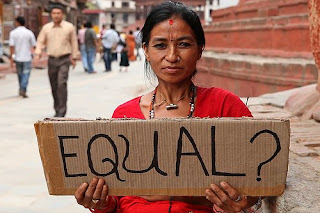In the United States, since the beginning of our history, we
have fought for our freedom… but by we I mean women and by freedom I mean the
power struggle to achieve what men already have.
Gender inequality is the battle we have yet to be victorious
in and its history begins long ago from a global standpoint. All throughout
history women have been depicted as the inferior sex.
For the United States, this journey has simply been a glimpse
in time. The Women’s Movement between the years of 1848 and 1920, began to
reveal the affects of inequality between the sexes. Women were fed up with the
fact that they were unable to make decisions for themselves and in this case
unable to contribute to the vote.
Here, though
women were seeking to have the equal rights to vote, it opened up a window of
discussion that shed light on a more general unfair treatment.
Today, we
continually see the variables this gender gap has. Women on average are payed
79 percent of what men are paid in the work place, women have what we call
today a tampon tax which is unfair taxing on women’s hygiene products where men
do not have a tax, and in the United States women find themselves as the lowest average of leaders in top corporations or positions compared to the rest or the
world.
As you can
see in the graphic below, it demonstrates that when looking a both small and
large business’s women in the U.S still have a long way to go in promoting the
progression of female leadership roles as countries like Russia and Turkey.
 |
| Credits to: Jana Kasperveick |
However, even
though the statistics demonstrate better averages for female leaders in other
countries, the U.S female population deals with the superficial aspects of this
struggle for equal treatment. In the U.S, women have the ability to speak up at
all time, riot, and make change happen all under the safety of the First Amendment.
In other countries we have not even achieved this stage in the journey.
To Americans
things such as education, well being and safety, and freedom of sexuality are
all along the lines of even. In countries like India, Africa, and the Middle
East these common grounds all vary tremendously between the genders.
 |
| Credits to: Oswald Gracias |
In African andMiddle Eastern countries, the well being of women is put in jeopardy for the
sake of men. Concentrated in these areas due to tradition, women illegally undergo
a procedure of genitalia mutilation to receive honor In their village or
families. Though under African law Female Geneltalia Mutliation (FMG) is strictly
prohibited the odds of this law being enforced are slim to none the same
applies for Middle eastern countries who have a male dominated systems. If
girls wish to be excepted by their fathers after puberty their tradition is to
be upheld. The well being of these young girls is put at stakes all for the
sake of not being shamed or rejected from their families by the paternal
figureheads.
The women's movement in the West is beginning to understand that, although there are some
common characteristics, Third World women's struggles have important
differences which flow from different stages of economic, social and political
development. Nonetheless, women
of all backgrounds and statuses are attempting to break the barriers we have
been presented with for centuries and free ourselves from the chains society
has clipped on to our ankles.
Slowly but surely, this
gradual process of equality begins to level itself out ... and who knows at the
rate we are going it seems that women may one day over shadow men but a girl
can only dream.